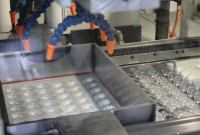Packaging serves both as protection and as appealing wrapping for many products. Yet, its use is controversial – particularly when it contains plastics. Martin Zirbs, Managing Director of Zirbs Verpackungen, knows the advantages and disadvantages of various packaging materials.
sweets processing: Mr Zirbs, wherever possible, you use recycled polyethylene terephthalate (PET) for your plastic packaging. Why don’t you use it for everything?
Martin Zirbs: Theoretically, it’s possible to use PET – or better said Eco-PET – with a 100 percent share of recycled material, but in some cases, official approval is not granted for this due to food product safety issues. The latest generation of extrusion systems provides the corresponding opportunity to make films that are food productcertified from 100 percent recycled materials. I think, it’s only a matter of time until this technology is available across the board. Until that time, we primarily use films with a recycled proportion of 80 to 90 percent.
sp: Premanufactured hollow chocolate parts are generally supplied in tablets. Can these tablets be recycled?
Zirbs: One can assume that many of these PET tablets are made with a high proportion of recycled material. Of course, it’s still possible, even desirable, that this material flows back into the recyclable material cycles. It’s no problem for the recycling process if there is chocolate or fat residue on the material, which is ground up into flakes in cutting mills, washed, dried and processed into new film at a temperature of around 240 °C.
sp: How often can a plastic be recycled?
Zirbs: This is another question for which there is no simple answer. Many plastics from the thermoplastics category, especially polyolefin groups such as PP or PE, can fundamentally be recycled numerous times, but can no longer be used in primary food product contact. In contrast, PET can be returned to the materials cycle several times. It can be assumed that under optimum conditions PET can be recycled six to nine times on average. What’s decisive is careful handling with these materials and their consistent return into the materials cycle.
sp: Can paper replace plastic when compliant with the applicable regulations in the sweets, baked goods and snacks segments?
Zirbs: No, I don’t think so. This already doesn’t make much sense for ecological reasons. Paper also requires valuable raw materials that are not available in an unlimited supply. At present, each year forested areas roughly the size of Switzerland are lost to cover the demand for fresh fibres. In this situation in particular, the focus has to return to the recyclability of paper. Generally speaking, paper can be recycled around three times, since the wood fibres become shorter with each recycling process and lose their natural cohesive properties. In the manufacture of recycled paper, this is compensated by adding around 30 percent fresh fibres. Another aspect is that with paper only the fibre proportion, some 60 percent of the total mass, can be recycled. Lacquers, printing inks, adhesives and filling materials comprising around 40 percent remain and have to be disposed of. The terms MOSH and MOAH are closely related to this.
sp: What would make recycling plastics easier?
Zirbs: Minimizing the types of plastics used in the packaging sector, along with clear, easily understandable labelling, and instruction and sensitization to the topic already in our schools would significantly ease and improve the situation. In the most literal sense, recycling and plastics should be more transparent, simpler and more understandable.
sp: What would you wish for regarding more conscious handling with plastics?
Zirbs: Fundamentally, the predominant negative attitude toward plastics in the packaging sector needs to change. Consumers should have a more appreciative perception of these materials as secondary raw materials instead of seeing them negatively as “stupid plastic waste”. Without a positive attitude toward plastics, we’ll never really be able to achieve positive results. I would wish for greater understanding and clarification for resource conservation and the recycling economy in these areas.
sp: Your wide-ranging portfolio also offers complete packaging. What do you focus on in particular here?
Zirbs: We pay special attention to recyclability and resource conservation in our assortments and products. With sensible, well thoughtout combinations, complete packaging for food products can already consist of 80 to 100 percent recycled material today. In this regard, we are especially vigilant in ensuring that the individual components can be separated in a manner that is logical and understandable for the consumer. In many cases, the barrier properties of plastics even make the use of recycled paper possible. Additionally, we are increasingly seeking to persuade our customers to use transparent moulded parts wherever possible, since they are particularly suitable for reuse or deployment as materials.
sp: What trends are you currentlyobserving?
Zirbs: At the moment, we are observing two developments: many packaging manufacturers endorse the sustainable use of proven materials like paper, recycled paper and conventional plastics, as well as their return to future-oriented material cycles. But unfortunately, we repeatedly see packaging created under the guise of special sustainability that is made particularly from materials that cannot be recycled, and therefore actually represents more of a disruption in established cycles.
http://www.zirbs-verpackungen.de





